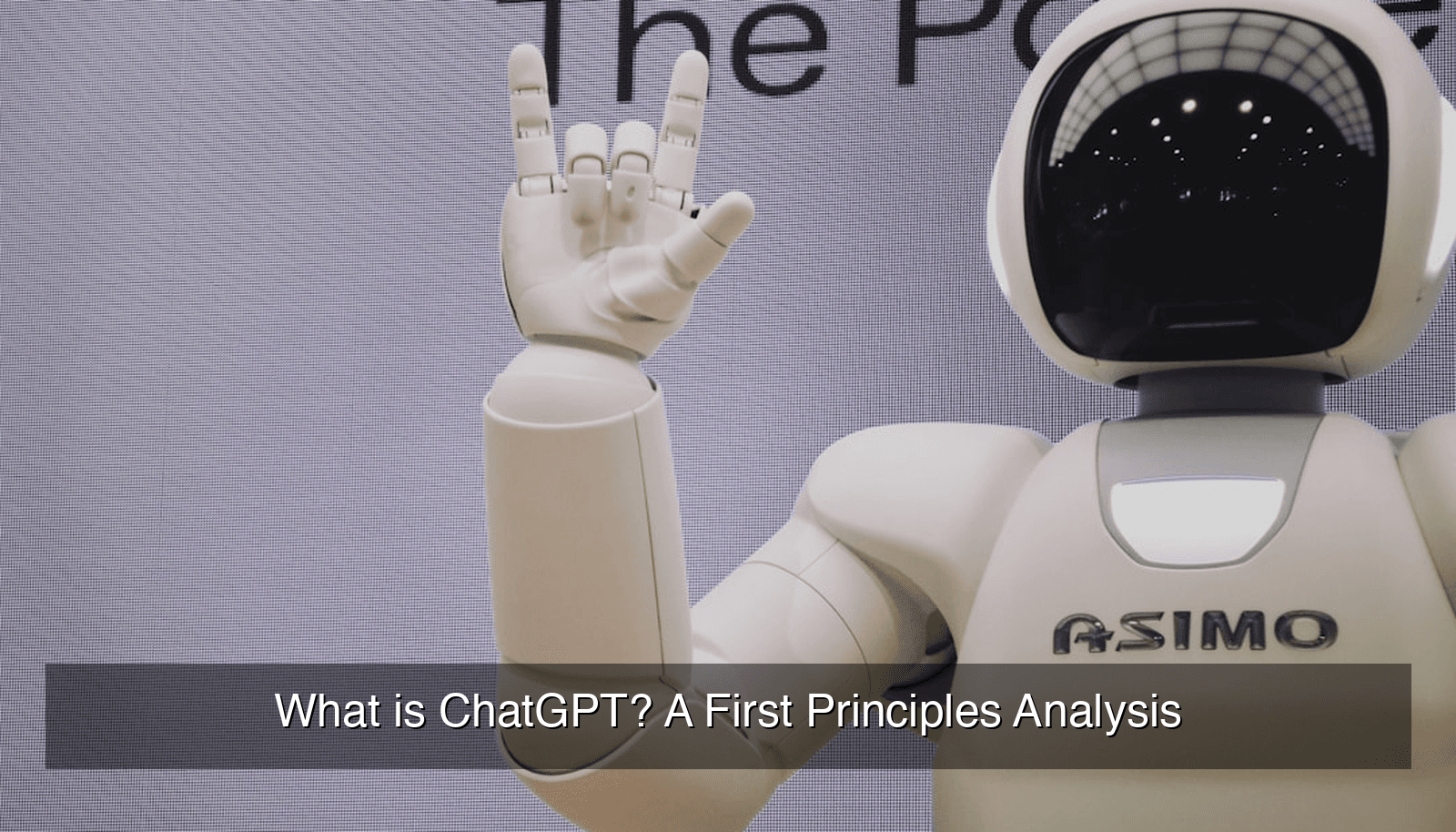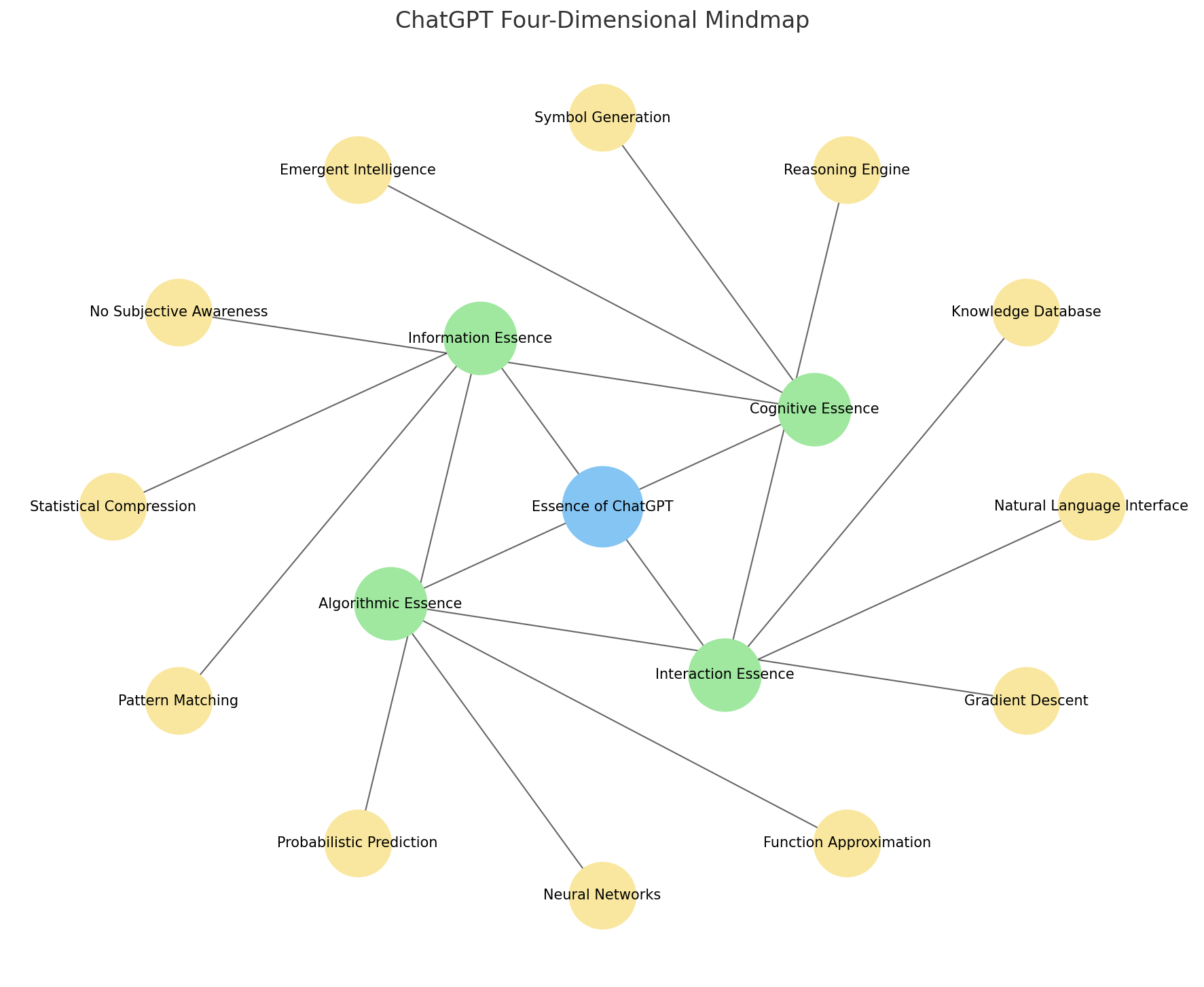

What is ChatGPT? A First Principles Analysis
Strip away the hype and marketing to understand what ChatGPT truly is at its core—a first principles breakdown of information, algorithms, interaction, cognition, and utility.
When we ask "What is ChatGPT?", most explanations anthropomorphize it as "an AI assistant" or "an intelligent chatbot." But these descriptions obscure rather than illuminate. To truly understand ChatGPT, we must deconstruct it to first principles—examining its fundamental nature across five dimensions: Information, Algorithm, Interaction, Cognition, and Utility.
This analysis reveals ChatGPT not as artificial "intelligence" in the human sense, but as something more specific and more interesting: a probabilistic language pattern generator that produces emergent behavior resembling thought through massive-scale statistical function approximation.

Figure 1: ChatGPT's four-dimensional essence framework
From a first principles perspective, ChatGPT's core nature is a statistical information compression and recombination system.
What it does:
What it does NOT do:
The fundamental operation: ChatGPT encodes statistical regularities of human language into a compressed form (model parameters), then decompresses and recombines these patterns in response to input prompts. The compression ratio is extraordinary—trillions of tokens of training data compressed into hundreds of billions of parameters.
This is fundamentally different from a database or search engine. A database stores information explicitly. ChatGPT stores patterns of information implicitly as numerical weights distributed across its neural architecture.
At its algorithmic core, ChatGPT is a massive-scale neural network functioning as a universal function approximator.
The fundamental mechanism: Through gradient descent optimization, it encodes the statistical regularities of human language into hundreds of billions of parameters. These parameters constitute a complex mathematical function that maps:
Input Text → Probability Distribution Over Next Tokens
Key architectural components:
The learning process: During training, the model adjusts billions of parameters to minimize prediction error across the training corpus. The optimization is not rule-based or symbolic—it's purely statistical pattern extraction through backpropagation.
What emerges: The trained function can interpolate and extrapolate linguistic patterns in ways that were never explicitly programmed. This is function approximation at unprecedented scale—approximating the function that generates human language.
From the user's perspective, ChatGPT's essence is a natural language interface to a statistical knowledge and reasoning engine.
The paradigm shift: Traditionally, accessing computational capabilities required:
ChatGPT inverts this model. Instead of humans adapting to machine constraints, the interface adapts to human communication patterns.
What this enables:
The power is not omniscience: ChatGPT's strength is not "knowing everything." Rather, it's the ability to:
The limitation is statistical boundaries: It can only recombine patterns present (explicitly or implicitly) in its training distribution. Truly novel information or reasoning beyond its training scope remains inaccessible without external tools or retrieval.
First principles analysis reveals: ChatGPT is neither human-like intelligence nor a simple search engine. It is a "anthropomorphic symbol generation system" producing intelligence-like behavior through statistical emergence.
Where the "intelligence" comes from: Not from consciousness, understanding, or intentionality, but from emergent properties of statistical patterns at scale:
What it lacks:
The illusion of thought: The appearance of thinking arises because language itself evolved to express thought. By predicting language patterns, ChatGPT generates sequences that *look like* the product of reasoning—because reasoning and language are deeply intertwined in the training data.
This is not deception or simulation in a pejorative sense. It's a profound insight: complex behavior can emerge from simple probabilistic rules applied at sufficient scale.
Ultimately, ChatGPT's essence is as a cognitive augmentation tool—an external memory and reasoning system that extends human capabilities.
What it amplifies:
What it does not replace:
The appropriate mental model: Think of ChatGPT as an external cognitive module:
It remains a tool—sophisticated and powerful, but fundamentally dependent on human direction, validation, and integration into purposeful workflows.
Combining these five dimensions of first principles analysis, we arrive at a complete definition:
ChatGPT is a large-scale neural language model that functions as a probabilistic pattern generator, trained via statistical compression of human text to create a function approximator with hundreds of billions of parameters. This function maps input text sequences to probability distributions over potential next tokens. Through this mechanism, it produces emergent behavior that resembles human thought and communication, serving as a natural language interface to a vast statistical encoding of linguistic and factual patterns. It operates as a cognitive augmentation tool—extending human capabilities for knowledge access, reasoning assistance, and language generation—without possessing consciousness, understanding, or intentionality.
In simpler terms: ChatGPT is a probability-based language pattern generator that, through massive-scale parameter function approximation, produces emergent behavior in human language that appears similar to "thinking."
Why this matters for understanding GEO: Understanding ChatGPT's true nature—as a statistical pattern matcher rather than a knowledge database—fundamentally shapes optimization strategy:
This is why optimizing for ChatGPT requires different approaches than traditional SEO. You're not optimizing for an algorithm that counts keywords or links—you're optimizing for statistical pattern recognition at massive scale.
Understanding ChatGPT's first principles nature has practical implications:
For users:
For developers:
For organizations:
- ChatGPT is fundamentally a statistical pattern compressor and generator, not a knowledge database or conscious entity
- Its "intelligence" emerges from probabilistic pattern matching at massive scale, not from understanding or reasoning
- The system functions as a universal function approximator mapping input text to probability distributions over next tokens
- As a natural language interface, it democratizes access to computational capabilities previously requiring technical expertise
- ChatGPT serves as a cognitive augmentation tool—extending human capabilities without replacing human judgment
- Understanding its statistical nature is crucial for both effective use and effective optimization strategies
Why ChatGPT Optimization Will Persist
Now that you understand what ChatGPT is, discover why optimizing for it represents a long-term structural necessity using first principles thinking.
Read Why GEO PersistsChatGPT Search Optimization Strategies
Apply your understanding of ChatGPT's statistical nature to implement effective optimization strategies that leverage pattern recognition.
Learn Optimization StrategiesUltimate Guide to Generative SEO
Explore comprehensive strategies for optimizing across all AI systems, building on the foundational understanding of how these models work.
Master Generative SEONow that you understand what ChatGPT truly is, learn how to optimize your content for statistical pattern recognition at scale.
Contact Us